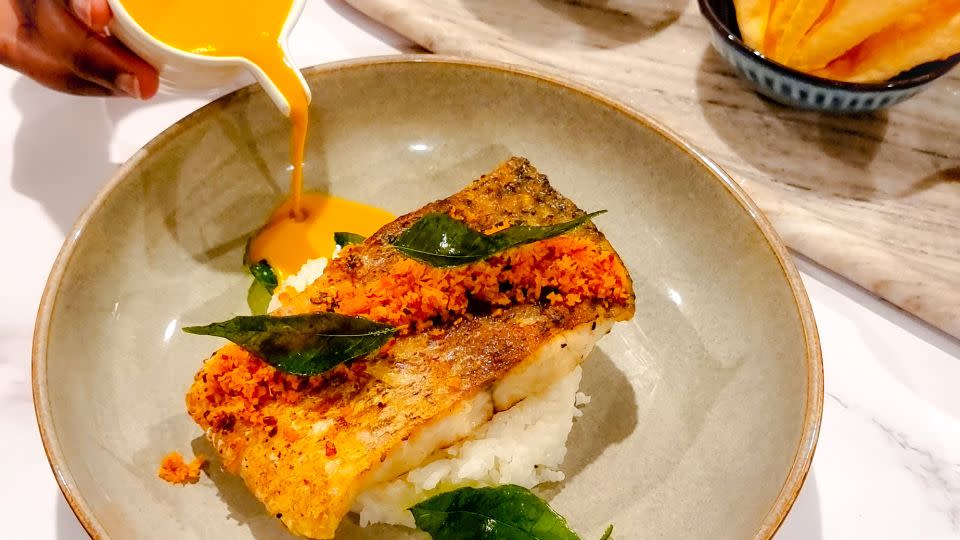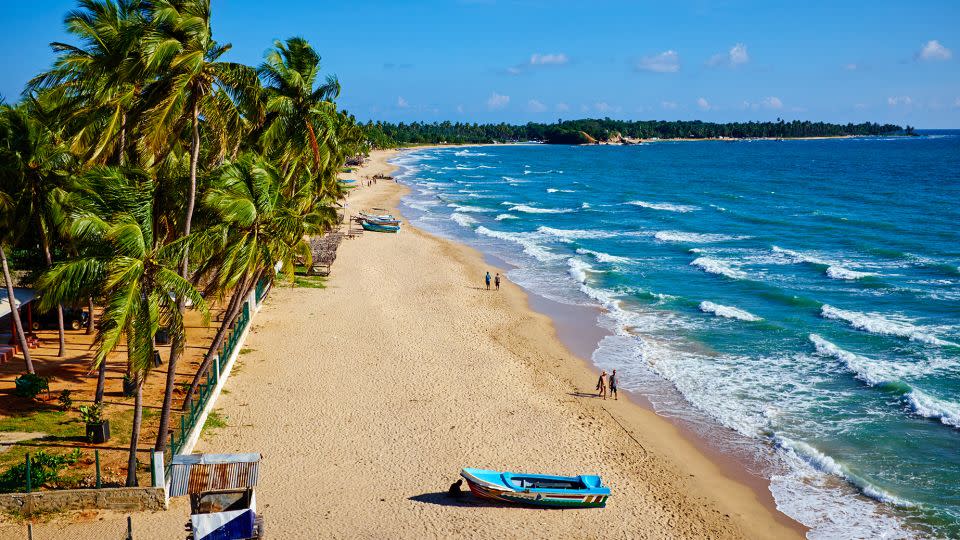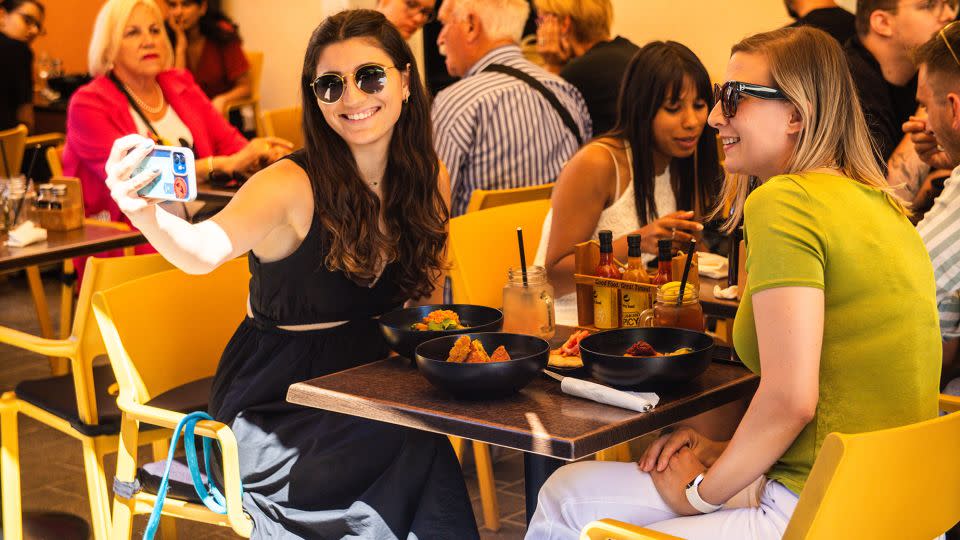Little island, big flavors: Sri Lankan food finally gets its due
When Kolamba first opened in 2019, many diners who walked into the charming eatery in central London’s Soho district weren’t familiar with Sri Lankan cuisine.
They thought it was just like Indian food, says the restaurant’s co-founder, Aushi Meewella, who grew up in Sri Lanka.
“We felt Sri Lankan food was underrepresented in central London, so we wanted to bring the dishes we grew up on and missed when we moved away,” she tells CNN.
While Sri Lanka is India’s little neighbor, with only 22 million people, its food and culture are quite different.
And now, a new generation of Sri Lankan chefs and entrepreneurs across the world is shining the spotlight on their native cuisine, while embracing the country’s diverse culinary heritage.
The tourism connection
The increased visibility of Sri Lankan cuisine has “been a long time coming,” Meewalla says. “But now, more and more Sri Lankans themselves are willing to take a chance on our own cuisine, open restaurants, and spread our cuisine to the world.”
Meewella credits tourism for the recent surge in interest and support for Sri Lankan food.
Although tourist arrivals were halted by a series of setbacks including a deadly bomb attack, the Covid-19 pandemic, and, more recently, the country’s worst-ever economic crisis, Sri Lanka is back on the tourism radar, already tracking over 800,000 visitors in 2023 as of the first week of August. As Meewella explains it: “People visit, discover our diverse island, and try our food, which they realize is also delicious.”
Chef Dhayanie Williams, a contestant on “MasterChef Australia 2019,” says the rise of social media in the last decade and programs like Masterchef have also helped professional and home chefs promote Sri Lankan food in the international market.
“We’ve seen many participants stick to their roots and create authentic Sri Lankan dishes on these programs,” says the chef, who is known for the Sri Lankan crab curry and chicken curry she cooked on the show.
“This continuous online exposure makes people try out Sri Lankan food in restaurants.”
Diverse influences
Today, more and more Sri Lankan chefs across the world are championing Sri Lankan food while defying common misconceptions about the cuisine.
“It has helped change the global perception that Sri Lankan food is different from Indian food, and it’s not only a lot of curries paired with rice,” Williams says.
For example, despite sharing a name, Sri Lankan roti are smaller, thicker “discs” made of freshly grated coconut and rice flour, unlike the large Indian rotis, which are made of wheat.
Rice, coconut milk, native fruits, vegetables and seafood act as the building blocks of Sri Lankan cuisine.
Meewella explains that it draws inspiration from diverse ethnic cultures and the influences of the Dutch and Portuguese, who once ruled Sri Lanka.

At Kolamba, mains include mutton poriyal, a common preparation in the Tamil-populated northern region of Sri Lanka in which the meat is dry-fried with onions, green chili and lime.
One popular dessert is watalappam, a coconut and palm jaggery custard prepared by Muslims to celebrate Eid.
Meewella points out that Sri Lankan cuisine is also heavily plant-based with many vegan options, which helps the cuisine stand out and resonate with global audiences. “This way of eating is not a fad for us,” she adds.
For centuries, Sri Lankans have made use of wild and organically-grown ingredients like jackfruit, water spinach and yams, blending them with spices and herbs, and frying and currying them to create dishes with unique flavors. Kolamba’s menu pays homage to these plant-based recipes with dishes like breadfruit curry cooked with coconut milk and raw green banana fried with grated coconut.
In Sri Lankan cooking, the white flesh of the coconut is grated and squeezed to prepare rich, creamy coconut milk, which thickens different vegetable and meat-based curries.
Fresh coconut milk is also added to a morning smoothie-like drink called kola kenda, made with herbs and rice. During celebratory events like the New Year or the first day of a job, Sri Lankans also cook coconut milk with rice to prepare a creamy breakfast called kiribath.
“When I hosted brunches at home, I didn’t expect there would be an appetite for dishes like kiribath, but people fell in love with the flavors of my childhood,” says Sam Fore, a Sri Lankan-American chef based in Lexington, Kentucky.
“Eventually, the demand got so great that I set up a tent behind a bar in town to start selling the food I was cooking.”
Within two years, Fore’s pop-up got nationwide attention for spotlighting simple recipes incorporating Sri Lankan elements. Now, Fore is ready to open her first restaurant in Lexington.

Spicy, sour, sweet
Although people assume that Sri Lankan food is spicy, it’s made up of many other spices and herbs besides chili. Coriander seeds, black pepper, mustard seeds, nutmeg, cinnamon, cardamom, curry leaves, pandan leaves and lemongrass are all used to flavor and scent dishes.
Spices are also roasted and ground together to make different types of curry powder, an essential flavoring agent.
These varied flavors of Sri Lankan cuisine apply well to common culinary techniques, Fore says.
For instance, she prepares fried chicken, a dish Americans are familiar with, but infuses it with the spices of Sri Lankan chicken curry, grinding and combining them with buttermilk to carry the flavors.
“I don’t dumb the spices down in my dishes,” Fore says. “I try to honor the recipes passed down to me and introduce flavors to diners that appear unexpectedly, but in a way that makes them understand my point of view.”
Across the world, chefs like Fore aren’t shying away from using innovative approaches to introduce Sri Lankan cuisine.
At Nadodi, a Kuala Lumpur restaurant that serves elevated Sri Lankan and South Indian fare, Williams came across a dish called “Yesterday.” This dish was reminiscent of Sri Lankan diya bath or pazhaya soru kanji, a day-old rice soaked overnight in water and eaten with dried, cured chilies.
Nadodi serves it with fried dry fish and pickles, all layered in a mini clay pot. “The dish is authentic and awakens one’s memories through elevating flavors, and plating it in a sophisticated way,” Williams says.
In Zagreb, Croatia, Brian Senaratne, co-founder of the city’s popular Sri Lankan restaurant Curry Bowl, shares similar values.
“We preserve original flavors, but keep it simple,” he says. “Usually, when we (Sri Lankans) go to a restaurant, we order several curries and rice separately, and share it with the entire group, but we noticed that European diners each order a dish. So having 10-15 curry dishes on the menu will only make it very complicated.”

Instead, Senaratne simplified this decision-making process for his diners, most of whom are European and haven’t previously had Sri Lankan food, by introducing curry-based bowls that also look appealing.
The theater of making some dishes also helps them stand out. Curry Bowl’s top seller is kotthu, a popular street food made by smashing roti with vegetables, eggs and meat on a metal grid with metal clamps, leading to a distinctive metal-on-metal sound.
“This was quite a show for the first-comers,” says Senaratne. “They hear the noise, come inside, and are completely amazed. We’ve had many people who try kotthu, hear about Sri Lanka from us and end up visiting Sri Lanka.”
As chefs and entrepreneurs across the world add their unique touches to native dishes, both Fore and Williams believe that interest in Sri Lankan food will continue to expand.
“As the cuisine grows, it’s going to take some creative applications of flavors like chili, lime and tamarind for a full crossover into the international palate,” Fore says. “It’s up to us as cooks to honor our roots while innovating for the future. I cannot wait for casual Sri Lankan food to become a nationwide craving across America.”
For more CNN news and newsletters create an account at CNN.com

